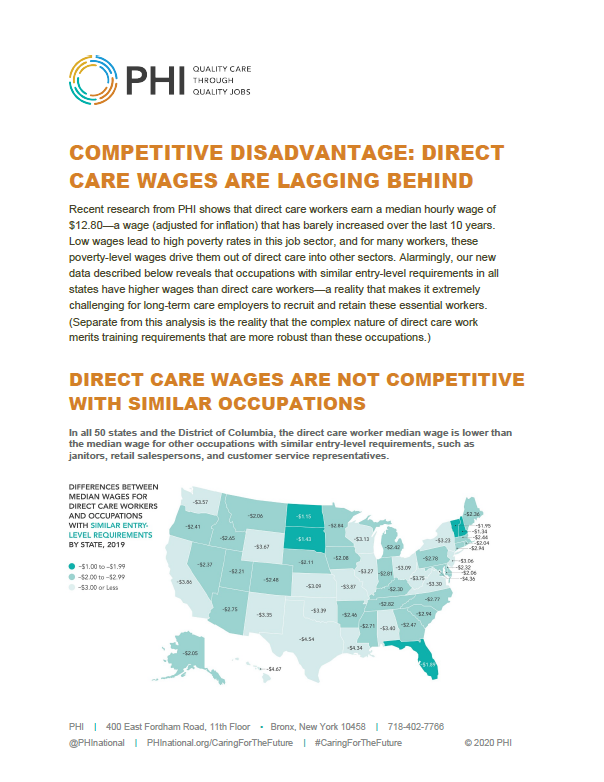Wages for direct care workers are untenably low and have barely budged over the last 10 years. As a result, direct care workers are often forced into poverty, cannot make ends meet or support their families, and end up leaving this field for other industries, such as fast food and retail. Exacerbating their impoverishment is the alarming reality that many direct care workers lack access to full-time schedules and critical supports such as health coverage, paid sick days, comprehensive paid family and medical leave, or affordable childcare and long-term care support. Unfortunately, policy proposals that aim to increase wages for low-wage workers (including direct care workers) are rarely paired with an increase in public funding that would help long-term care employers cover these higher wages without cutting service hours for older adults and people with disabilities. The entire long-term care system needs sufficient funding and reform to improve the economic wellbeing of these essential workers.
RECOMMENDATIONS
To improve economic security for direct care workers and ensure that direct care jobs are competitive with other occupations, we recommend the following:
Pay direct care workers a living wage. Providing a living wage to direct care workers would support their economic security, decrease turnover, improve care, and boost the economy (through increased consumer spending and a reduced reliance on public benefits). Policymakers should establish wage floors for these workers that are aligned with their skills and experience and tied to the cost of living in their geographic areas. To prevent cuts in long-term services and supports (LTSS), these wage measures must be accompanied by increased public reimbursement rates.
Improve access to full-time schedules for direct care workers. One in four part-time direct care workers reports being unable to find full-time work with their employer or on the wider labor market, while others work part time because they are raising children, helping other family members, or in school. Providers should be adequately financed to provide full-time hours to every worker who wants them. Policymakers should also study the scheduling barriers that long-term care employers and direct care workers face, and invest in evidence-based technology solutions that help align employers’ scheduling requirements with workers’ availability, offer workers more control over their schedules, and streamline the connection between self-directing consumers and potential workers.
Strengthen the social safety net and improve access to workplace benefits for direct care workers. Affordable health insurance, free or low-cost childcare, paid sick leave, paid family and medical leave, and retirement savings options are critical elements of economic security, among others. Policymakers should strengthen the social safety net by extending these benefits to all low-wage workers, including direct care workers. In the meantime, long-term care reimbursement rates should be structured to account for the cost of providing these benefits to direct care workers through their jobs.
Evaluate the unintended impact of wage increase measures on direct care workers, their employers, and consumers. While essential to direct care workers’ economic well-being, policies that increase wages can have unintended consequences. For example, unless paired with an increase in Medicaid funding and reimbursement rates, new wage requirements can force long-term care employers, including self-directing consumers, to cut service hours or reduce staffing levels. Additionally, because of benefit cliffs and plateaus, low-wage workers might see their total compensation remain the same or even drop when their wages increase because of a corresponding decrease in public benefits. Policymakers should evaluate the impact of policies that increase wages on direct care workers’ total compensation, the financial stability of employers, and consumers’ service hours—and devise strategies to address any unintended negative effects.








